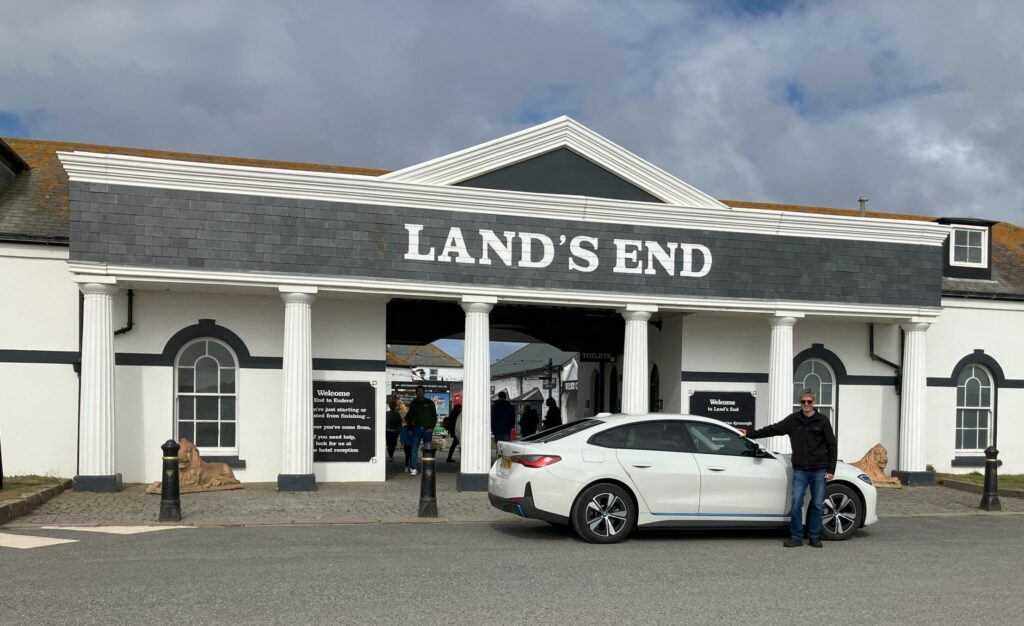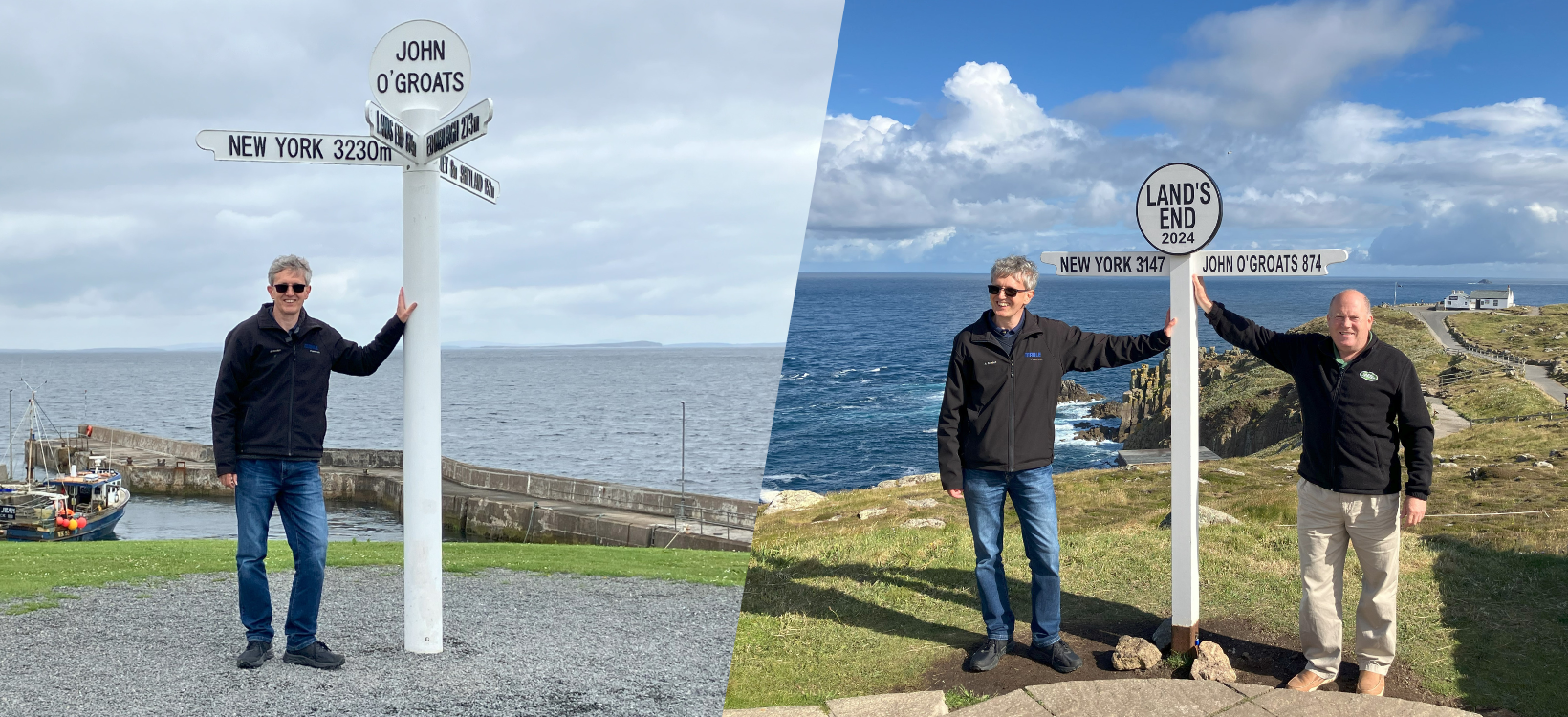

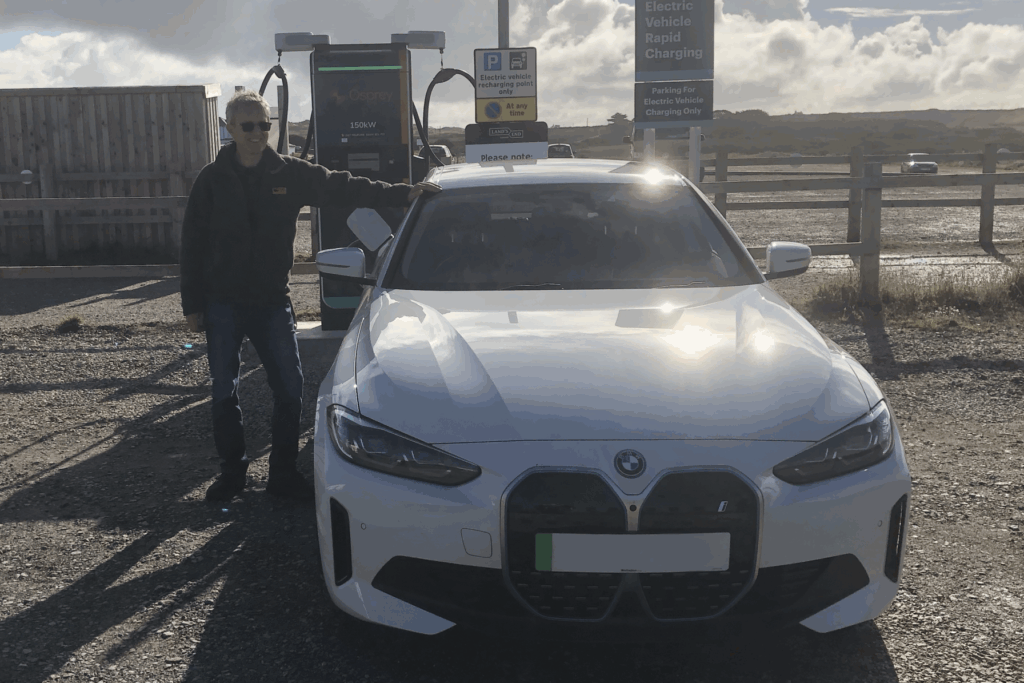
EVA England member Andy Stodart has been interested in electric cars for about 6 years. Having spent 37 years working on the design and development of internal combustion engines, you might not think of him as the most obvious advocate for EVs. But as an engineer by profession, Andy recognises the advantages of electric motors: efficiency, power & torque density, refinement and reduced parts count.
After test-driving over a dozen models, he chose a BMW i4 eDrive40. And two and a half years later, it has proved to be an excellent choice, giving great efficiency and range. Andy regularly drives 300miles on a single charge, often completing his journey with 30miles of range remaining. That got him thinking about using it to show that EVs can also handle long-distance journeys.
Andy wanted to demonstrate that the rapid and ultra-rapid recharging infrastructure is mature enough to enable such a journey to be easily undertaken, and that modern EVs can take full advantage of this infrastructure to be quickly recharged, if the optimum charging strategy is adopted.
And what better challenge than the ultimate long-distance journey in the UK: John O’Groats to Land’s End. In July 2024, Andy set out to complete the 842-mile trip in record time, aiming to beat the existing record of 15 hours and 24 minutes set by Richard Symonds in a Tesla Model S 100D, whilst observing all national speed limits.
In the blog post below, he tells us all about this journey.
The journey was undertaken in a BMW i4 eDrive40, which has an 80.7kWh usable battery capacity and 207kW maximum charging speed. With my co-driver, Keith Walker, we planned to complete the trip overnight in order to minimise the impact of traffic on our journey. We set off from John O’Groats at 5pm on Saturday 5th July, having charged the car to 100% at one of the three 75kW Osprey chargers.
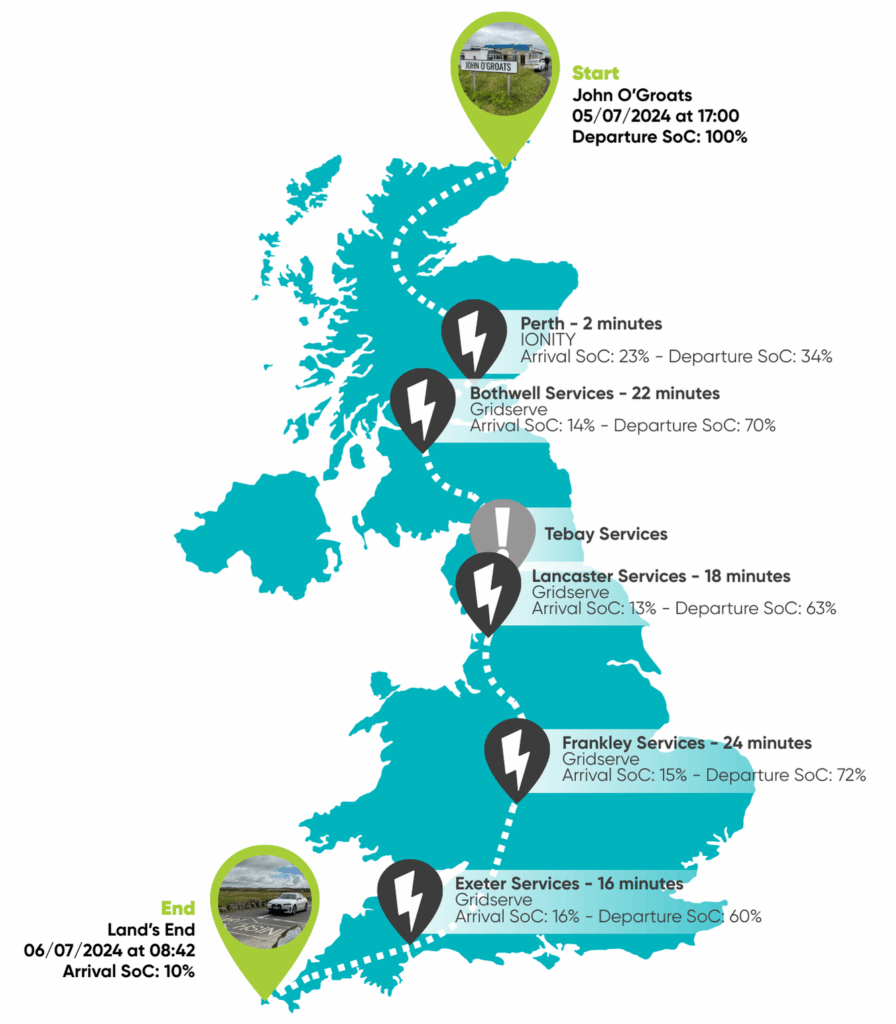
The BMW i4’s regenerative braking is very well-weighted, making 1-pedal driving effortless. In fact, I only used the brake pedal 3 times in the first 229 miles to Perth, where we made a very brief unscheduled stop.
Originally, I had hoped to drive directly from John O’Groats to the Bothwell Services on the M74, just south of Glasgow, but unfortunately, it was raining for much of the journey. The increased rolling resistance, coupled with the extra electric load from the air-con for demisting, lights and windscreen wipers, reduced the efficiency to 3.8miles/kWh. And so we made our first stop at one of the five 350kW IONITY chargers in Perth. A quick 2-minute top-up: just the time it took for a comfort break and enough to ensure that we would reach Bothwell with 14% State of Charge (SoC), to use one of the six 350kW Gridserve chargers there.
My intended strategy was to make 4 charging stops on the journey to Land’s End. It would have been possible to do the journey with only 2 stops, but this would have required charging the car to 100% SoC on route, something that takes longer than charging the car to a lower SoC. EVs also charge fastest from a low SoC, which means that stopping more frequently is more time-efficient.
For instance, charging from 10 to 60% takes less time than charging from 30 to 80%. In both cases, 50% SoC is being added, but the rate at which charge is added (the charging power in kW) is fastest when the battery is at a low state of charge. At low states of charge, the BMW will charge at up to 200kW. However, by the time the battery is up to 50% charge, the charging power drops to 100kW, i.e. half the charging speed (see graph below).

During our trip, I was attempting to minimise charging time, so our strategy was to drive until the battery was down to 10-15% and then only charge enough to get to our next stop, with 10-15% SoC. We set the charging stops close enough to each other, such that our highest charge was only 72%.
Another important consideration when trying to minimise the duration of charging stops was the power of the chargers. All our pre-selected charging stops had chargers offering more than 200kW charging power, ensuring that the charging speed was always limited by what the car could accept, not what the chargers could provide.
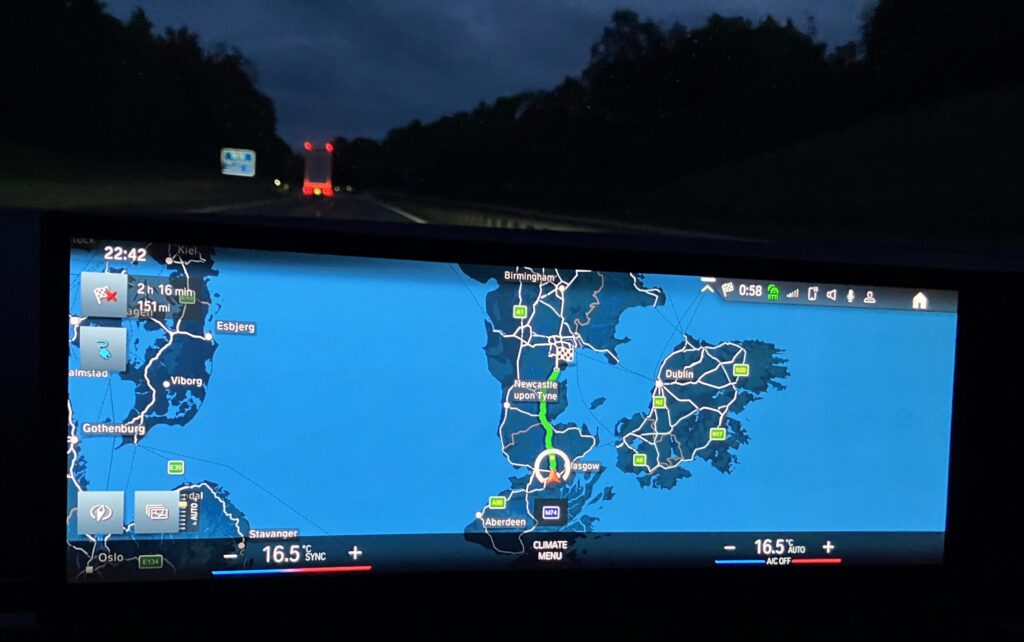
At Glasgow, we charged the car to 70% in 22minutes. At this point, my co-driver, Keith, who had been asleep until now, took the wheel as we set off for our next stop at Lancaster Services in the Lake District, and it was my turn to go to sleep.
Two hours later, I was woken by Keith asking if we should follow the sat nav’s recommendation and stop at Tebay services. I was only half-awake, so we pulled in and parked next to a charger. Once I properly woke up, we realised why the car had proposed the additional stop: if the car calculated that the state of charge would be less than 16% at the intended destination, it would propose an additional stop.
As we got ready to leave again, without charging, we noticed that the couple in a Nissan Ariya parked next to us looked in some distress. It turned out they were on their first long journey in their new EV, with only 30 miles of range left and 50 miles away from home, but both of the chargers were out of order. This is the scenario that all non-EV drivers or those new to EV driving most worry about.
They didn’t have, or know of, Zapmap, so I helped them download it and quickly showed them that Killington services were only 11miles away, where all of the 6 chargers were working. Relieved, they were soon on their way.
I worry that this experience put them off EV ownership, but I can only hope that since then, they have changed their minds. This experience also taught me that new EV drivers don’t always get given the necessary information or tools to make the experience as stress-free as it should be. And I feel that in these situations, it is our responsibility, as experienced EV drivers, to help in any way we can.
Sadly, our “good deed for the day” had cost us valuable time in our attempt at the record for driving an EV from John O’Groats to Land’s End. We were never able to make up the time, but I took great comfort in knowing that I had helped an EV owner in their time of need.
From then on, every charging event passed seamlessly, as should be expected with any contactless rapid charger.
Each charging stop was conducted with near “F1 pits-stop” style efficiency. The car was immediately put on charge before taking any comfort break, food or drinks. The total time that the vehicle was stationary was typically only about 3 minutes longer than the charging time. This accounted for exit and entry from the vehicle, plugging in and disconnecting, initialising and ending the charging process.
We arrived at Lancaster services with 13% SoC, where we then added another 50% in 18 minutes, courtesy of one of the six 350kW Gridserve chargers.
The next stage took us to Frankley Services, South of Birmingham. After another 24-minute stop at one of the twelve Gridserve chargers, I took over driving again for the stage to Exeter Services.
This location has 24 ultra-rapid chargers, but as with all of the locations since Perth, we were the only EV using them. This was the final charging stop and took just 16 minutes of charging time.
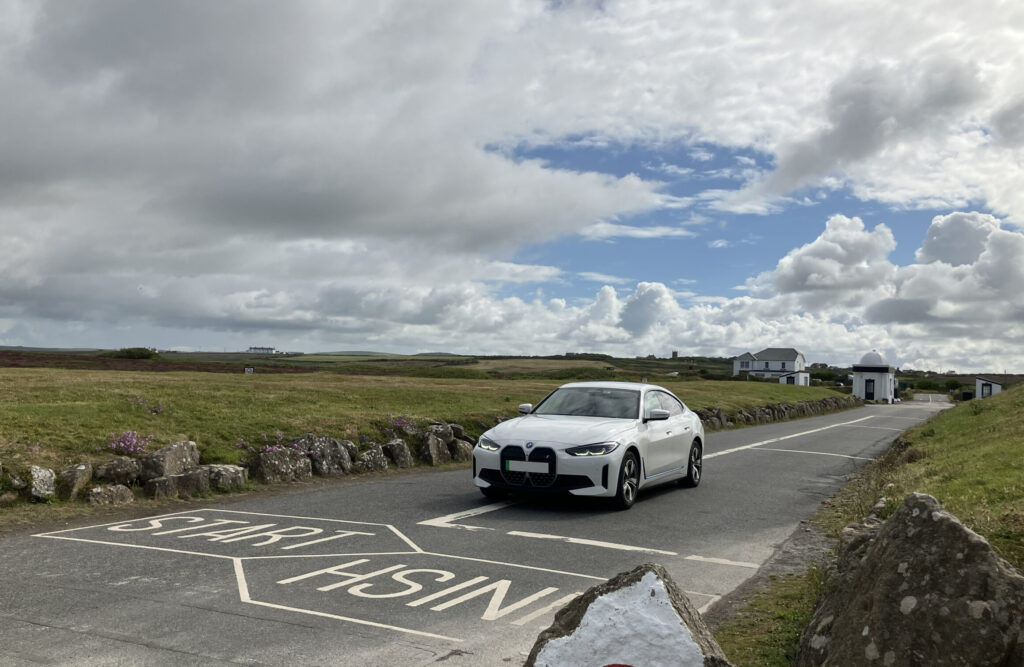
The final stage of the journey was from Exeter Services to Land’s End. The particular challenge of this stage was to add “just enough” energy to reach Land’s End while minimising any unnecessary time spent charging.
We pulled in at Land’s End with 9% SoC, so I’d say I judged it pretty well. Incidentally, we arrived at 8:42 am, having driven 842 miles. Quite a pleasing coincidence.
If we’d undertaken this journey in a petrol or diesel car, allowing for a single 15-minute refuelling stop, it could have been done 11% quicker. However, most people would choose to (and probably should) take more and longer breaks when undertaking such a long journey.
In practice, with an efficient charging strategy, the increase in journey time when using an EV is quite small. On our trip, all the chargers were working and available, making the charging process seamless. We might not have beaten Richard Symonds’s record, but my aim to demonstrate that long-distance EV travel is not only possible but can be effortless and enjoyable was successfully achieved.
